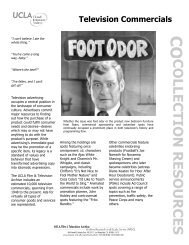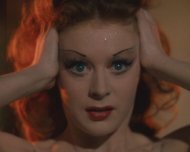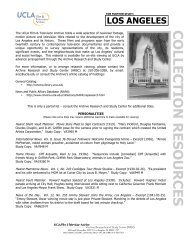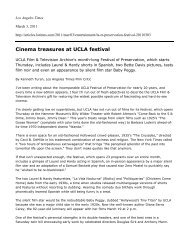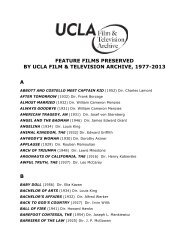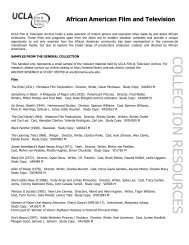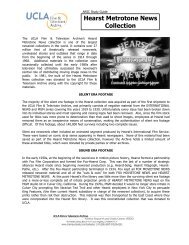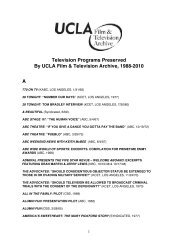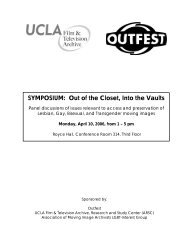"Heroic Grace" catalog - UCLA Film & Television Archive
"Heroic Grace" catalog - UCLA Film & Television Archive
"Heroic Grace" catalog - UCLA Film & Television Archive
You also want an ePaper? Increase the reach of your titles
YUMPU automatically turns print PDFs into web optimized ePapers that Google loves.
The Shaw Brothers studio was the leading producer of new school<br />
wuxia movies, putting them out in two cycles: the first from 1965 to 1971<br />
(typified by the early work of King Hu and Zhang Che [Chang Cheh]) and<br />
the second from 1976 to 1981 (notably a long series adapted by director<br />
Chu Yuan [Chor Yuen] from the wuxia novels of Gu Long), book-ending the<br />
so-called “kung fu craze” of the early to mid-’70s. Shaw defined their<br />
reconfiguration of the genre as a “progressive movement” that broke<br />
with the “conventional ‘stagy’ shooting methods” of the old school—<br />
referring not only to the Cantonese wuxia serials of the 1950s, with their<br />
cartoonish special effects, but also to the long-running series of kung fu<br />
B films about Wong Fei-hung, with their stiff, stage-derived action<br />
sequences. 1<br />
Rather than attempt to achieve supernatural effects such as flying<br />
swordsmen (a feat accomplished with the use of wires), or martial arts<br />
fighters projecting inner-body energy or qigong from their palms and<br />
becoming invulnerable to knives and swords, Shaw’s first new school<br />
cycle made a virtue of realism, especially in depicting action and violence.<br />
However, not even the new school could forsake fantasy altogether,<br />
not without fundamentally changing the shape of the genre. The movie<br />
that propelled the new school into mainstream box-office popularity,<br />
King Hu’s COME DRINK WITH ME (1966), was in fact an amalgam of new<br />
school concepts and old school magic.<br />
Immediately breaking the old school mold of artificial violence, COME<br />
DRINK WITH ME begins with scenes of graphic mayhem as bandits attack<br />
a convoy: we see hands hacked off and soldiers impaled with swords<br />
which stick out of their backs. These scenes showed that in terms of<br />
technical effects Hong Kong cinema was coming of age. (From my experience<br />
as a kid watching the old Wong Fei-hung movies of the ’50s, I well<br />
remember that the method of depicting somebody being run through<br />
was to have the victim grasp the sword in his armpit.) And in a sequence<br />
set in a tavern, Zheng Peipei (Cheng Pei-pei), as the character Golden<br />
Swallow, faces down a group of enemies with a set of martial arts parlor<br />
tricks of the sort popularized by the Japanese blind swordsman Zatoichi.<br />
(When they hurl coins at her, she catches every one by threading her<br />
hairpin through their central holes.) The movie in these early scenes<br />
establishes a set of relatively realistic conventions and limitations for<br />
its swordplay, in effect spelling out the natural laws of the world in<br />
which the story takes place.<br />
But in a later episode Golden Swallow comes upon the drunken beggar<br />
Fan Dabei (Yue Hua), referred to in the English subtitles as Drunken Cat,<br />
practising his palm-projecting power in the forest. She is startled to discover<br />
that Fan is actually a martial artist with supernatural powers who<br />
has only been posing as a drunkard for reasons of his own. In the downto-earth<br />
context that has been carefully established, the supernatural<br />
powers of Fan and his adversary, the apostate monk Liao Kong (Yang<br />
Zhiqing), are like intruders from another level of reality, which is to say,<br />
from the jiang hu of legend. In other words, King Hu mixes old school<br />
styles of action with the new school styles, which he felt obligated to<br />
include in COME DRINK WITH ME.<br />
1 See Nanguo Dianying [Southern Screen] (Hong Kong), No. 92 (October 1965), p. 30.<br />
24<br />
The fantasy element remained embedded in the wuxia movies of the<br />
new school: Zhang Che, known as a master of realistic violence, was just<br />
as likely to portray flying swordsmen in the early films of his wuxia<br />
cycle, notably TRAIL OF THE BROKEN BLADE (DUANCHANG JIAN, 1967), HAVE<br />
SWORD WILL TRAVEL (BAOBIAO, 1969), THE WANDERING SWORDSMAN (YOU<br />
XIA’ER, 1970), and THE HEROIC ONES (SHISAN TAIBAO, 1970). Zhang’s mixture<br />
of macho violence and supernaturalism further blurred the distinction<br />
between realism and fantasy.<br />
The element of pure fantasy only really took a back seat (for a time)<br />
when the kung fu movie broke onto the scene in the early 1970s. Kung<br />
fu’s emphasis was on “real fighting,” a concept that was meant to counter<br />
the tradition of supernaturalism in wuxia, and was reinforced by the<br />
involvement of actors who were genuine martial artists (as typified by<br />
Bruce Lee) rather than those unschooled in actual fighting skills and<br />
merely mimicking the motions. This emphasis on realism is a much more<br />
important distinction between wuxia and kung fu than the preference for<br />
armed or unarmed combat. In the wuxia genre, the knight-errant is<br />
almost always a master of both unarmed and armed techniques. It is not<br />
uncommon in wuxia movies to see a fighter wielding a sword in combat,<br />
only to lose it and continue with his bare hands. At the height of the<br />
kung fu boom in the ’70s, Zhang Che in BLOOD BROTHERS (CI MA, 1973) and<br />
King Hu in THE VALIANT ONES (ZHONGLIE TU, 1975) showed such a progression<br />
occurring naturally in the course of battle, demonstrating that the<br />
directors most responsible for the wuxia resurgence of the mid-’60s had<br />
by then gracefully accepted the switch from wuxia to kung fu.<br />
The rise of kung fu was presaged in the new school wuxia era by the<br />
Cathay studio’s marvelous production FROM THE HIGHWAY (LUKE YU DAOKE,<br />
1970), directed by Zhang Zengze (Chang Tseng-chai). The film is set in the<br />
northern Chinese plains during the early republican era and features a<br />
hero who fights only with his hands. The hero’s main adversary is a bandit<br />
leader whose favorite weapon is his bald head, which he uses as a<br />
battering ram; another villain uses his pigtail as a whip. Obviously, the<br />
notion of “real fighting” in FROM THE HIGHWAY cannot be taken too literally,<br />
but must be grasped as cinematic representations of violence and<br />
fighting techniques based on allegedly real kung fu traditions. The movie<br />
marked a turning point in the new school martial arts cinema because of<br />
its depictions of unarmed combat styles but in the vein just this side of<br />
wuxia folklore.<br />
Shaw Brothers was immediately on cue with the Zhang Che opus<br />
VENGEANCE! (BAOCHOU, 1970), released a few months after FROM THE HIGH-<br />
WAY. The preponderance of unarmed combat, complemented by the use<br />
of daggers and short swords, and even guns, confirmed that the transition<br />
from wuxia to the next phase of martial arts cinema was well in<br />
progress. VENGEANCE! is often erroneously cited as the first pre-Bruce<br />
Lee kung fu movie in Hong Kong cinema; that honor really belongs to<br />
FROM THE HIGHWAY. However, the former’s early republican setting and<br />
David Jiang Dawei’s (David Chiang’s) all-white wardrobe offered a foretaste<br />
of Bruce Lee’s FIST OF FURY (JINGWU MEN, 1972), 2 while the appearance<br />
of firearms and the Beijing Opera background, linking operatic performances<br />
with death and violence (countersigned by Zhang’s use of slow<br />
motion), foreshadow the 1980s “bullet operas” directed by Zhang’s former<br />
assistant and protégé John Woo.<br />
The new school reached a culmination in the late ’60s, with two magnificent<br />
works: Wang Xinglei’s ESCORTS OVER TIGER HILLS (HUSHAN HANG,<br />
1969) and King Hu’s A TOUCH OF ZEN (XIA NÜ, begun in 1968 but released in<br />
1971), both shot in Taiwan with injections of talent and money from Hong<br />
Kong. ESCORTS is a wry study of the pursuit of xia (chivalry). It centers<br />
2 Lee’s films were released out of sequence in the US and with confusingly re-shuffled<br />
titles. FIST OF FURY became THE CHINESE CONNECTION in the US; the movie known<br />
in the US as FIST OF FURY was released in Hong Kong as THE BIG BOSS (TANGSHAN DA<br />
XIONG, 1971).



